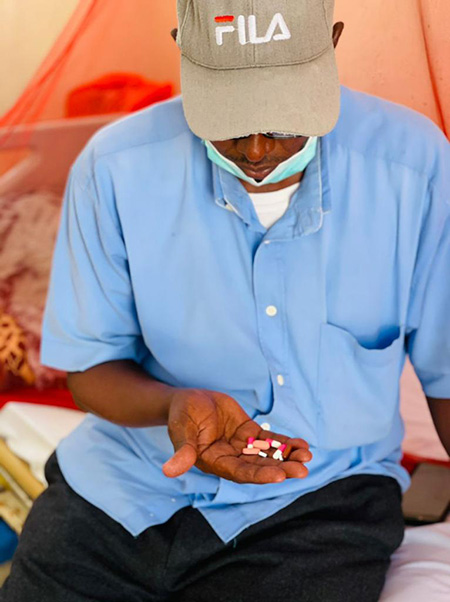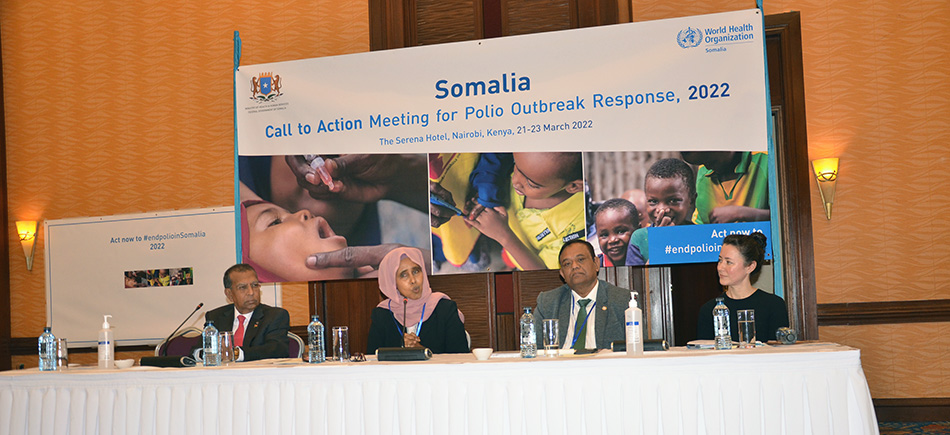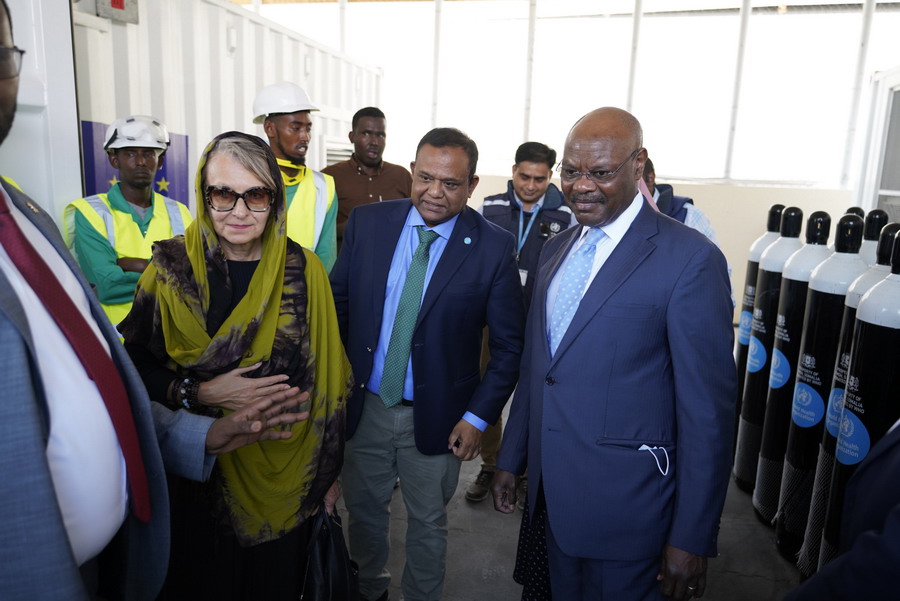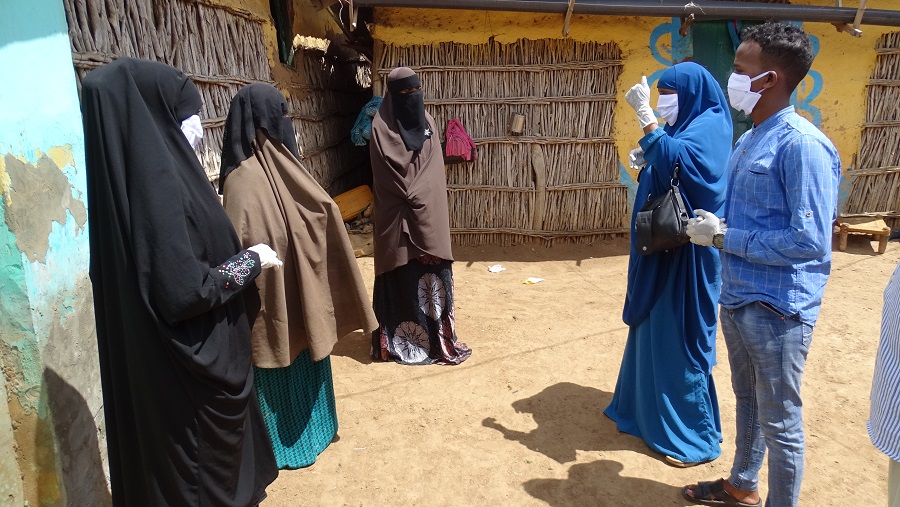World TB Day 2022: Getting back on track to diagnose and report TB cases, to save lives
 27 March 2022 - World Tuberculosis (TB) Day, commemorated on 24 March every year, aims to increase awareness about the grave health, social and economic consequences of TB, and scale up efforts to prevent further spread of the disease. The theme for this year is to ‘Invest to End TB. Save Lives’.
27 March 2022 - World Tuberculosis (TB) Day, commemorated on 24 March every year, aims to increase awareness about the grave health, social and economic consequences of TB, and scale up efforts to prevent further spread of the disease. The theme for this year is to ‘Invest to End TB. Save Lives’.
TB is a major cause of death and disease burden in Somalia. The 2021 Global TB Report indicated there was a marginal increase in the estimated TB incidence in Somalia, from 258 per 100 000 people in 2018 to 259 per 100 000 in 2020. However, the death rate in Somalia remained at 68 per 100 000.
Effects of COVID-19 on the TB programme
Reporting cases and addressing them in a timely manner is crucial in stopping the spread of TB. However, the minimal increase in the number of cases reported in Somalia in 2020 and the plunge in global TB notification, which went from 7.1 million in 2019 to 5.8 million in 2020, can be attributed largely to the COVID-19 pandemic. The global death rate also increased in the same period, as people worldwide refrained from visiting health facilities due to a fear of being infected with COVID-19.
In 2020, an estimated 1.3 million HIV negative people died of TB, up from 1.2 million in 2019, while an additional 214 000 HIV positive people died. Of the cases reported in 2021, 17 204 were drug-sensitive cases, while 299 were drug-resistant cases.
“Somalia’s TB programme is now gradually recovering from the effects of the COVID-19 pandemic though, with 17 503 TB cases notified in 2021, as compared to 17 200 reported in 2020,” said Dr Abdiaziz Mohamud Shire, National TB Programme Manager, Federal Ministry of Health and Human Services. “Even though we are making progress, we still need more support in the form of GeneXpert machines and outreach activities. Both are important for case detection.”
Limited awareness and incorrect diagnosis
Despite its prevalence, health personnel are still missing the mark in terms of timely diagnoses, and people like Adow Adan Abdi are still unaware of the symptoms of TB. Around a year-and-a-half ago, Adow began to cough a lot but thought he probably had a simple cold. At a clinic in Tiyeglow, the doctors gave him antibiotics and syrup for the cough, but only after two weeks of visits. On seeing no improvement, they referred Adow to a private clinic in Baidoa, Bay region, to run blood tests, where they confirmed he had TB and prescribed medication as treatment. Adow had to buy it himself though.
For the first four months, the symptoms decreased, but during the fifth month, Adow returned to Tiyeglow as his cough was back. He lost his appetite and lost more weight. His situation deteriorated and he even began to cough blood and pus. When Adow became severely ill, his family took him to the Manhal TB centre in Waberi, Mogadishu, for support. They took a sample of sputum and tested it, and then referred him to the Forlanini Multi-drug-resistant-Tuberculosis (MDR-TB) Centre for treatment, where he finally received the right attention.
Adow, who is still in the Forlanini Hospital for now, is relieved that his medication, along with counselling, are helping him. He has even made good friends with the hospital staff, whom he says are very helpful, and with other patients recovering from TB. They have their meals together and discuss their experiences, which has helped him feel much better.
After three months of treatment, Adow is starting to gain weight. Even though he feels ready to leave, the hospital staff have requested him to stay on until his joint inflammation reduces.
Adow says he feels more people need to know that TB is curable and can be prevented. He is grateful that agencies such as WHO are supporting health facilities with modern testing equipment for TB, and requests decision-makers to consider supporting TB patients with nutrition.
New technology being used for TB testing
WHO has supported the Federal and State Ministries of Health in Somalia to use rapid molecular diagnosis as the primary tool for TB diagnosis. In 2021, half of all presumptive TB cases in Somalia had access to GeneXpert testing, while 61% of all sputum smear-positive cases were diagnosed using GeneXpert tests.
In 2021, Somalia had 99 Tuberculosis Management Units (TBMUs) and 50 GeneXpert machines distributed across the country. Twenty-two GeneXpert machines were used in the diagnosis for both TB and COVID-19. The three MDR-TB centres in Mogadishu, Hargeisa and Galkayo treating multi-drug resistant TB operated normally with no major challenges reported. The culture laboratories in Hargeisa and Mogadishu continued to perform Line Probe Assays 1 and 2 (LPA 1 & 2), to detect mycobacterium tuberculosis and drug resistance, under the supervision of the Uganda Supranational Reference Laboratory.
In 2021, 89% of the TB cases in Somalia were tested for HIV co-infection. Of these, only 0.9% were found to be co-infected. The Ministry of Health, WHO HIV Team, and UNICEF provided around 64% of the TB cases with co-infections access to antiretroviral treatment (ART) to help treat HIV.
Collaboration from partners
“Our investments so far have reaped double benefits by saving lives by testing for both TB and COVID-19,” said Dr Mamunur Rahman Malik, WHO Representative to Somalia and Head of Mission. “By further scaling up our investments in TB prevention, we can ensure all Somalis, everywhere, know more about how TB is spread, and have equitable access to prevention and care. This will help us to reach Universal Health Coverage.”
The Global Fund supports the TB elimination programme in Somalia financially through World Vision International, which is the principal recipient of funding. International and local nongovernment organizations run the TB centres as sub-recipients of the Global Fund TB grant, while the independent monitoring body monitors the entire programme. The TB Coordination Team that brings together the national TB programme (NTP), WHO, World Vision International and major implementing partners continues to be the decision-making body of the programme. It reviews TB elimination activities twice in a year to address any challenges that the programme faces.
As the technical organization supporting the national TB programme, WHO supports capacity development, drug management, development of treatment guidelines and reporting materials, and data management, and guides the World Vision in the implementation of strategies.
Somalia and stakeholders commit to act now, to take urgent, bold steps to end the ongoing circulating poliovirus type 2 outbreak and keep the country free from wild poliovirus

NAIROBI, 22 March 2022 – Yesterday, the Federal Government of Somalia, World Health Organization (WHO) and members of the Global Polio Eradication Initiative (GPEI) recommitted to stopping the ongoing outbreak of circulating poliovirus type 2 (cVDPV2) in Somalia at a three-day meeting convened in Nairobi, Kenya. High-level delegates at the meeting included HE Fawziya Abikar Nur, Federal Minister of Health and Human Services, Dr Mamunur Rahman Malik,
WHO Representative to Somalia and Head of Mission, alongside senior representation from the Bill & Melinda Gates Foundation (BMGF), the Centers for Disease Control and Prevention (CDC), Rotary International, Save the Children, the United Nations Children’s Fund (UNICEF), and other UN agencies and partners.
Together, the Government, GPEI partners, which include WHO, UNICEF, the BMGF, CDC, Rotary International, GAVI, the Vaccine Alliance, and other key partners endorsed the Somalia Polio Eradication Action Plan 2022 to reaffirm their commitment.
The Somalia Polio Eradication Action Plan 2022 outlines a four-point call to action to stop the spread of the current outbreak, which is one of the longest lasting cVDPV2 outbreaks to be reported so far. The robust plan aims to direct partners’ efforts and resources towards boosting population immunity, making concerted efforts to reach high-risk populations — including inaccessible and nomadic communities and internally displaced persons — to strengthen their immunity, enhancing the search for poliovirus circulation, and strengthening coordination among all stakeholders. Some of the strategies that will be deployed include intensifying efforts to offer 5 opportunities for vaccination against polio in 2022, providing routine childhood immunization in high-risk locations, where children have missed out on vaccinations, and strengthening community engagement. Given how easy it is for the cVDPV2 virus to spill over international borders, the emergency plan also advocates for stronger cross-border coordination among the polio eradication programmes in Somalia, Kenya, Ethiopia and Djibouti.
“In the midst of the ongoing drought, and while recovering from the effects of the COVID-19 pandemic, our stakeholders must not forget how important it is to contain the ongoing poliovirus outbreak so that it does not spread any further and does not affect any more children’s lives,” said HE Fawziya Abikar Nur, Federal Minister of Health and Human Services. “On this occasion, I would like to extend my sincere gratitude to all our partners, and donors, for the immense efforts they have put into shielding millions of Somali children from polio over the years.”
“Since its inception 25 years ago, Somalia’s polio eradication programme has made progress, including by stopping outbreaks of wild poliovirus and, recently, one of circulating poliovirus type 3 in 2021. The programme has established a vast network of polio workforce and assets and we can do more not only to stop the current outbreak but to achieve broader health system goals through integration and effective use of our human and operational resources. Since 2018, Somalia has conducted several supplementary immunization campaigns. Despite these efforts, pockets of unvaccinated children remain, due to insecurity and limited access to health services,” said Dr Mamunur Rahman Malik, WHO Representative to Somalia.
The Somalia Polio Eradication Action Plan, which will be implemented in 2022, complements one of the goals outlined in the GPEI ‘Polio Eradication Strategy 2022–2026: Delivering on a Promise’, to stop cVDPV transmission and prevent outbreaks in non-endemic countries. It is also in line with Somalia’s national goals and UN Sustainable Development Goals (SDGs).
For additional information, please contact:
Khadar Hussein Mohamud
Head of Coordination and Communications, Ministry of Health
Federal Government of Somalia
Fouzia Bano
Communications Officer
WHO Somalia
WHO and EU hand over life-saving medical oxygen plant to Somalia: a landmark achievement in bridging gaps in oxygen supply in the country

MOGADISHU, 18 March 2022 – On 17 March 2022, Dr Mamunur Rahman Malik, the World Health Organization (WHO) Representative and Head of Mission to Somalia, handed over a duplex pressure swing adsorption (PSA) oxygen plant to H.E. Fawziya Abikar Nur, the Minister of Health of Somalia, alongside H.E. Tiina Intelmann, European Union (EU) Ambassador to Somalia and Mr Adam Abdelmoula, Deputy Special Representative of the United Nations Secretary-General and UN Resident and Humanitarian Coordinator (DSRSG/UNRC/HC) for Somalia. This milestone event took place at the De Martino Hospital in Mogadishu where the oxygen plant is currently installed. The De Martino Hospital is a specialized hospital serving the capital city and Banadir, the most populated region in Somalia.
WHO handed over the PSA plant to the Federal Government of Somalia at a small ceremony. The plant was procured with generous funds received from the EU Delegation to Somalia through its ongoing support for the emergency response to COVID-19 in the country. The PSA oxygen plant inaugurated today was the first of its kind to be procured and installed at the De Martino Hospital as part of WHO’s vision to build an inclusive and equitable health systempost-COVID-19, together, with its partners and Ministry of Health and Human Services.
“We are very grateful to WHO and the EU Delegation for the support they have offered to Somalia for this medical oxygen. The PSA oxygen plant they have provided is placed in our national specialized hospital for COVID-19 patients, the De Martino Hospital and can serve up to 25 intensive care patients facing dire health challenges at once, while another unit refills cylinders. Together, they can fill 100 40-litre oxygen cylinders in a day,” said H.E. Fawziya Abikar Nur, the Federal Minister of Health and Human Services in Somalia. “This support is part of a strategic roadmap to boost oxygen supply in hospitals across the country.”
“Simple medical oxygen is effective in treating many health challenges – including COVID-19 and surgical, emergency and critical care services, such as trauma. In 2018, pneumonia was estimated to kill around two children aged under five every hour in Somalia and yet global evidence shows that simple medical oxygen can reduce up to 35% of child deaths. It is so crucial and yet has no substitute,” said Dr Mamunur Rahman Malik. “After noting its scarcity in Somalia during the COVID-19 pandemic, WHO mounted a speedy response, and provided medical oxygen as a smart, cost-effective investment to save more lives. In the coming months, WHO will continue to work to procure more medical oxygen to Somalia to bridge the gap in access.”
Mr Adam Abdelmoula said, “WHO is using a two-pronged approach to offering medical oxygen – while offering medical oxygen to health facilities and the Government, they are also training health care workers, biomedical engineers and technicians in using the installed oxygen plants, with support from the EU and other partners. These steps are essential in improving a health system and advancing towards health-related Sustainable Development Goals.”
The EU Ambassador, Tiina Intelmann, highlighted that this support to the Government through WHO is an important part of the EU-funded COVID-19 response work in Somalia. This oxygen plant installed at De Martino Hospital is the first one of such devices funded by the EU, with the two additional ones currently under deployment in Garowe and Hargeisa. The EU Ambassador explained that the EU support aimed at suppressing COVID-19 in Somalia, which initially started with humanitarian aid, was continued through a partnership with WHO and the Federal Ministry of Health in order to further support the strengthening of the health sector. EU support is not only focused on critical oxygen provision but also includes a vaccination campaign through the COVAX initiative.
At the onset of the COVID-19 pandemic in Somalia in March 2020, none of the public sector hospitals had medical oxygen available and the health workforce was not trained on its use. Since then, WHO has worked with partners to procure, install and deliver PSA oxygen plants for large specialized hospitals, solar-powered medical oxygen systems for small hospitals and oxygen concentrators for primary health centres to ensure high-grade medical oxygen is available at points of care for every patient struggling to breathe.

-------
For additional information, please contact:
• Khadar Hussein Mohamud, Head of Coordination and Communications, Ministry of Health, Federal Government of Somalia,
• Kyle DeFreitas, External Relations Officer, WHO Somalia,
• Fouzia Bano, Communications Officer, WHO Somalia,
• Vicente Selles, Liaison Officer/Communication Programme Manager,
Note to Editors
Please visit the links below for additional information:
How a gloomy night brought a bright light in the fight against COVID-19
Every breath counts: utilizing the COVID-19 response to increase access to oxygen
Solar-powered oxygen delivery in Somalia: the vital need beyond COVID-19
Historical moment for Somalia as COVID-19 vaccines arrive through COVAX Facility
Anticipatory action and timely response help avert major outbreaks and protect the most vulnerable from health effects of drought
 Community health workers explain methods of disease prevention. Credit: WHO/Somalia
Community health workers explain methods of disease prevention. Credit: WHO/Somalia
10 March 2022 – Somalia has witnessed intermittent drought over the last 3 decades. Each drought, and natural catastrophe, has brought with it a string of health consequences, magnified even further in a country with fragile and vulnerable health system.
CERF support delivering anticipatory action
To respond to an impending drought situation in Somalia during May to November in 2021, WHO provided timely support to the Ministry of Health and Human Services, with funding support from the Central Emergency Response Fund (CERF). Part of the support focused on the prevention and mitigation of the health consequences of drought through anticipatory action, while the other focused on delivering an urgent, swift response through the deployment of rapid response teams in affected districts.
Highlighting the progress made Dr Mamunur Rahman Malik, WHO Representative to Somalia and Head of Mission, said, “Our support prevented a major catastrophe when the country has still been reeling from the COVID-19 pandemic and its health system was yet to fully recover.” By considering Somalia’s previous experiences with drought, we were able to predict scenarios, prepare for, and respond to, difficult situations to save lives, and all the while offer essential primary health care services throughout the same efforts.”
Preventing and mitigating public health risks by anticipating effects of emergencies
In 2021, through the CERF anticipatory action project, WHO supported the ministries of health in Somaliland, Galmudug, Hirshabelle, Jubaland and Puntland to prevent and mitigate the public health risks of drought. In 11 high-risk districts earmarked by Somalia’s Health Cluster, WHO took measures to prevent the spread of diseases, reaching 163 266 people directly, 69 635 of whom were internally displaced people (IDPs) and 81 021 were women.
The project also enabled WHO to deploy health care workers, and rapid response teams, with a view to preventing disease spread and mitigating the health effects of drought at community levels. As a result, over 1100 outbreak alerts were detected and investigated in a timely manner. By enhancing surveillance for diseases, detecting, investigating and responding to alerts early, the country was able to avert larger outbreaks of diseases from cholera, measles and other epidemic disease, save lives and reduce the health consequences of drought.
The anticipatory action project has also supported scaling up of essential health care services, including treatment of severely malnourished children in nutrition stabilization centres across the states covered.
Through this support, WHO distributed medical supplies for treatment of severe acute malnutrition, cholera, malaria and pneumonia, thereby reaching 244 250 people, who had limited access to health services, with community outreach services.
Delivering a rapid response to public health challenges
As part of the second CERF-funded rapid response project, in 2021, in collaboration with state ministries of health, WHO deployed rapid response teams and community health workers to provide an urgent, essential health response for IDPs and host communities in 9 drought-affected districts in Somaliland, Jubaland and Puntland. Through this support, WHO directly reached 123 181 Somalis, 61 573 of whom were female.
Through this project, WHO deployed 324 community health workers who visited every household in drought-affected district to, report alerts to the rapid response teams for field investigation. These community health workers reported a total 2527 epidemic alerts, including for suspected measles, cholera, malaria and respiratory tract infections. The rapid response teams that were trained and deployed in 39 districts through this project investigated 1686 of these alerts triggered from the community health workers. These interventions prevented major outbreaks in drought-affected areas. In addition, WHO’s work helped to provide essential health care to over 491 206 beneficiaries.
Communities’ needs drive project activities
In places like riverine villages where Dahawo Muse Yusuf and her family live, these interventions support Somalis to be prepared for, and respond to, public health challenges.
Sitting upright on a bed at the Jowhar Regional Hospital, Dahawo explained how her village, Raqayle Umar Gudley, is affected every time the Shabelle River swells with floods, or runs dry through a drought. This is yet another time when Dahawo and her community have not been able to harvest crops since the last deyr rains failed, she adds grimly.
“We have no access to safe water and dig into the river bed to look for water sometimes,” said
20-year-old Dahawo. “I know of many people like me, from my village, who are suffering from diarrhoea due to drinking unsafe water. Once, an NGO – I can’t remember their name – gave us chlorine to clean water but that was just once.” When asked if she knew how to clean water, Dahawo chuckles and says they have not been able to discuss this issue at home, but that she would ask her husband, who is educated, to discuss with the community how to clean water to prevent diseases.
“People like Dahawo are suffering from diseases that can be prevented,” said Dr Mohamed Farah, the head clinician at the Jowhar Regional Hospital. “Many people also suffer from communicable diseases such as pneumonia, and acute watery diarrhoea, and several children are suffering from measles and severe acute malnutrition as the result of the drought. We are receiving patients from as far as Hiran and Jalaqsi. The situation is getting worse every day.”
Learning skills to prevent the spread of diseases
 WHO team visiting a stabilization centre in Baidoa, South West State, to provide technical support for integrated management of acute malnutrition, on 21 February 2022. Credit: WHO/ SomaliaThe two CERF-funded projects reached health care workers with different skill sets. In Belet Weyne, Nimca Kalil Mohamud, a nurse working at the Eljalle Health Centre offers women support to breastfeed their babies properly, and gives advice on family planning and nutrition.
WHO team visiting a stabilization centre in Baidoa, South West State, to provide technical support for integrated management of acute malnutrition, on 21 February 2022. Credit: WHO/ SomaliaThe two CERF-funded projects reached health care workers with different skill sets. In Belet Weyne, Nimca Kalil Mohamud, a nurse working at the Eljalle Health Centre offers women support to breastfeed their babies properly, and gives advice on family planning and nutrition.
She explained that she learnt a lot about the prevention of COVID-19 and the integrated management of childhood illnesses at a capacity-building session offered by WHO and the Government through CERF in 2021.
In addition to advancing skills and knowledge, such training also motivates health workers like her to do her job better, Nimca added.
Offering primary health care services to support affected communities
In continuing to ensure humanitarian aid reaches people affected by public health crises, WHO is supporting the Ministry of Health in Somalia in 2022 to ensure a rapid response intervention to mitigate the public health risks in some of the severest drought-affected districts of Galmudug and South West State.
Under these rapid response interventions supported by CERF, the project aims to increase communities’ access to primary health care services through fixed and outreach services, including the timely detection of and swift response to alerts of epidemic-prone diseases, as well as support risk communication, community engagement and health promotion activities. These efforts will continue to protect vulnerable populations from the adverse effects of drought.


